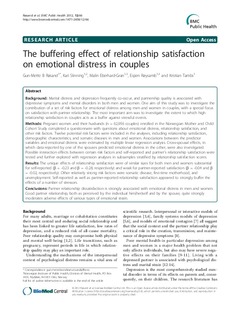| dc.contributor.author | Røsand, Gun-Mette Brandsnes | |
| dc.contributor.author | Slinning, Kari | |
| dc.contributor.author | Eberhard-Gran, Malin M C | |
| dc.contributor.author | Røysamb, Espen | |
| dc.contributor.author | Tambs, Kristian | |
| dc.date.accessioned | 2016-03-30T12:15:34Z | |
| dc.date.accessioned | 2018-08-07T11:05:15Z | |
| dc.date.available | 2016-03-30T12:15:34Z | |
| dc.date.available | 2018-08-07T11:05:15Z | |
| dc.date.issued | 2012 | |
| dc.identifier.citation | BMC Public Health 2012, 12 | |
| dc.identifier.issn | 1471-2458 | |
| dc.identifier.uri | http://hdl.handle.net/11250/2507853 | |
| dc.description | - | |
| dc.description.abstract | Background:
Marital distress and depression frequently co-occur, and partnership quality is associated with depressive symptoms and mental disorders in both men and women. One aim of this study was to investigate the contribution of a set of risk factors for emotional distress among men and women in couples, with a special focus on satisfaction with partner relationship. The most important aim was to investigate the extent to which high relationship satisfaction in couples acts as a buffer against stressful events.
Methods:
Pregnant women and their husbands (n = 62,956 couples) enrolled in the Norwegian Mother and Child Cohort Study completed a questionnaire with questions about emotional distress, relationship satisfaction, and other risk factors. Twelve potential risk factors were included in the analyses, including relationship satisfaction, demographic characteristics, and somatic diseases in men and women. Associations between the predictor variables and emotional distress were estimated by multiple linear regression analysis. Cross-spousal effects, in which data reported by one of the spouses predicted emotional distress in the other, were also investigated. Possible interaction effects between certain risk factors and self-reported and partner's relationship satisfaction were tested and further explored with regression analyses in subsamples stratified by relationship satisfaction scores.
Results:
The unique effects of relationship satisfaction were of similar sizes for both men and women: substantial for self-reported (β = -0.23 and β = -0.28, respectively) and weak for partner-reported satisfaction (β = -0.04 and β = -0.02, respectively). Other relatively strong risk factors were somatic disease, first-time motherhood, and unemployment. Self-reported as well as partner-reported relationship satisfaction appeared to strongly buffer the effects of a number of stressors.
Conclusions:
Partner relationship dissatisfaction is strongly associated with emotional distress in men and women. Good partner relationship, both as perceived by the individual him(her)self and by the spouse, quite strongly moderates adverse effects of various types of emotional strain. | |
| dc.language.iso | eng | |
| dc.title | The buffering effect of relationship satisfaction on emotional distress in couples | |
| dc.type | Journal article | |
| dc.date.updated | 2016-03-30T12:15:34Z | |
| dc.subject.nsi | VDP::Medisinske fag: 700::Klinisk medisinske fag: 750::Gynekologi og obstetrikk: 756 | |
| dc.subject.nsi | VDP::Midical sciences: 700::Clinical medical sciences: 750::Gynaecology and obstetrics: 756 | |
| dc.identifier.doi | 10.1186/1471-2458-12-66 | |
| dc.identifier.cristin | 917503 | |
| dc.subject.keyword | Depresjon / Depression | |
| dc.subject.keyword | Forhold mellom menn og kvinner / Relationships between men and women | |
| dc.subject.keyword | Psykisk stress / Psychological distress | |
| dc.subject.keyword | Tilfredshet / Satisfaction | |
